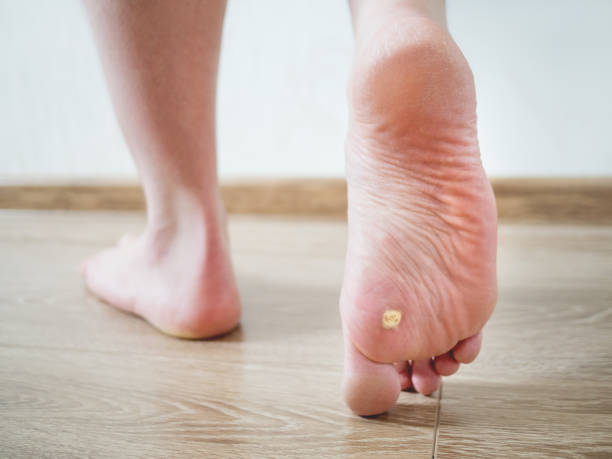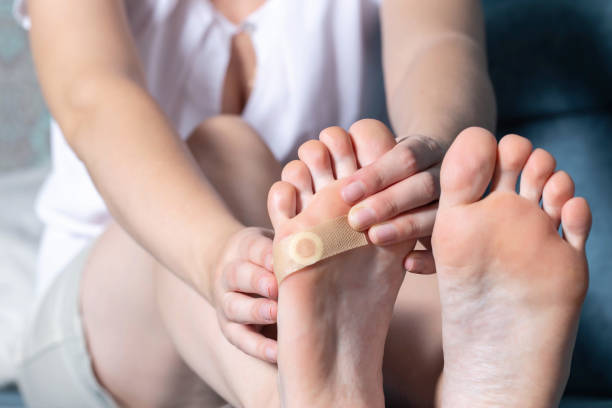Difference Between Corn And Wart: Causes, Treatment & Prevention

You might be confused about whether a wart or a corn is present if you have a growth or bump on your foot.
Both are able to grow on the feet. Even doctors have trouble distinguishing between them due to their similar appearance. Warts and corns aren’t the same things, despite their similarities.
Here are some tips on how to distinguish between them, as well as how to treat and prevent each.
Table of Contents
What is a Wart?
The feet are one location where warts can develop, but they can also appear elsewhere. On the body, they can appear anywhere. Fingers and hands are the most frequently affected areas.
Warts are a result of HPV (human papillomavirus). It is a contagious virus that spreads through both direct and indirect contact between people.
It’s interesting to note that not all warts appear right away after being exposed to the virus. One may not show up for up to 6 months after exposure.
The virus does not always cause warts to appear. Your body might be able to fight off the virus if you have a robust immune system.
Some warts may resemble corns in appearance because they are small, flesh-colored, and rough to the touch. Warts, however, stand out in that they also have a grainy appearance and are ringed by black dots or pinpoints.
Warts can be uncomfortable and appear in groups, but they are benign and eventually go away on their own.
What Causes Warts?
The human papillomavirus (HPV) infection causes warts to appear on the body. A person’s skin’s top layers of skin are penetrated by HPV when they come into contact with it (often through an opening like a scratch), and it then starts to speed up the rate at which your skin cells multiply. As a result, a lump that is rough and flesh-colored appears on the skin’s surface. The time between the virus’s initial infection and the development of a wart is typically several months.
If you touch someone else’s wart, you run the risk of contracting the virus because it usually spreads through casual skin contact. Additionally, because warts are inclined to grow on damp skin, they frequently spread through the sharing of washcloths, tea towels, or bath towels.
What is a Corn?
The result of constant pressure and friction is a thick layer of skin called a corn. They frequently manifest on the feet and toes as a result.
Corns resemble a raised, hard bump surrounded by dry, flaky skin, as opposed to warts, which have a grainy, fleshy appearance with black pinpoints.
Another significant distinction is that corns are neither contagious nor caused by a virus.
Because it puts too much pressure on your feet, wearing shoes that are too tight can result in corns. Or you can develop a corn if you wear shoes that are too loose because your feet will slide around inside the shoe all the time.
What Causes Corns?
In contrast to warts, corns are not brought on by a virus. Since they cannot spread from person to person, they are not contagious. Friction, on the other hand, is what causes corns. They develop, in other words, as a result of prolonged rubbing of the skin against another surface. Your feet will rub against the side of the shoe when you wear shoes that are too small and tight, which can result in this. A corn develops as a result of the skin becoming irritated by this. As an alternative, wearing shoes that are too large can result in corns because your foot will move around in the shoe, irritating the skin.
Spotting the Difference
Both plantar warts and corns are tiny, scaly skin growths with a hard center that are sensitive to touch. A closer inspection will however show slight variations in their appearance. A wart will typically be small, skin-colored, rough to the touch, grainy looking, and dotted with tiny black dots. (Depending on where on the foot’s sole it is, a plantar wart may also flatten under pressure.) Instead of having this grainy appearance, corn appears as a hard raised bump surrounded by dry, flaky skin. These variations result from the various wart and corn root causes, and it may be difficult to tell them apart.

How to Treat a Wart
Typically, warts disappear on their own and don’t need any kind of treatment. However, it can take almost as long—sometimes up to two years—for one to disappear as it can take them to appear, which can sometimes take up to six months.
Use an over-the-counter wart removal product to get rid of a bothersome wart faster. These come in the form of an ointment, liquid, or patch. They aid in wart liquefaction and softening.
In the event that these remedies are ineffective, your doctor might suggest a wart remover with prescription strength. They may also suggest other therapies, such as:
• liquid nitrogen to freeze off the wart
• laser treatments to burn off the wart
• minor surgery to cut off the wart
Duct tape is a common home remedy for wart removal, but opinions on its efficacy are divided.
Tape a wart for roughly a week to test this method. After removing the duct tape, soak the wart in water and use a pumice stone to carefully file away the dead skin.
How to Treat a Corn
Stopping the source of ongoing friction and pressure is the first step in treating a corn. Start putting on properly fitting shoes.
Use shoe inserts or pads inside your shoes to add more cushion and lessen the irritation.
Other self-care techniques include soaking your feet in water to soften the corn and then gently exfoliating the skin with a pumice stone.
To alleviate dryness or flakiness around a corn, you can also moisturize your feet.
Painful corn may be surgically removed by your doctor if home remedies are unsuccessful in alleviating the condition.
How Can You Prevent Warts and Corns?
Preventing Warts
Stay away from the virus directly to prevent developing a wart. With people who have warts, avoid shaking hands or holding hands. Never use pumice stones, nail clippers, or other personal care tools that belong to someone who has warts.
Avoid picking at warts or biting your fingernails if you have them. By doing this, the virus might infect additional body parts.
Preventing Corns
Make sure your shoes fit properly to avoid getting corn. Your toes in your shoes should be able to move. If not, the shoes are too small.
You need to get a smaller pair of shoes if your feet slide around in them.
The Takeaway
The two types of skin growths—a wart and a corn—are distinct even though they can look similar.
Knowing the differences between these two growths not only helps you determine whether you have HPV but also offers hints on how to treat them. If you do, you can take action to treat your symptoms and stop the spread of the infection.
Tags: Corn And Wart